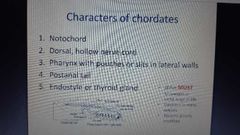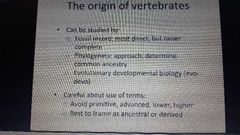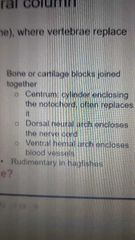![]()
![]()
![]()
Use LEFT and RIGHT arrow keys to navigate between flashcards;
Use UP and DOWN arrow keys to flip the card;
H to show hint;
A reads text to speech;
18 Cards in this Set
- Front
- Back
- 3rd side (hint)
|
What are the 3 Phylum of deuterostoma |
Chordata, Hemichordata, and Echinodermata |
Acorn worms and star fish |
|
|
What is the difference between deuterostoma and protostoma |
Anus or mouth develop first in embryo |
|
|
|
What makes hemichordata similar to chordata |
Pharyngeal slits |
Breathing |
|
|
Echinodermata had what types of symmetry |
Radial as adult and bilateral as larvae |
Adult and larvae |
|
|
What are the subphylums of chordata |
Urochordata, cephalochordata, and vertebrata |
U C and V |
|
|
What are the 5 features of chordates |

|
|
|
|
What is the nerve cord made of and what process forms it |
Ectoderm via invagination |
|
|
|
What is the endostyle and what does it do |
Glandular groove on the floor of pharynx secretes mucous and helps iodine metabolism |
|
|
|
Cephalochordata lack a |
Differentiated brain, sense organs and a heart |
|
|
|
Ascidiacea are...? |
Urochordata that start as swimming larvae that grow into tunicates (sea squirts) |
|
|
|
What are the 3 ways to study origins of vertebrates |

|
|
|
|
Few chordates fossils were found in this time period |
In the Cambrian 540-520 MYA |
|
|
|
Cyclostomes are? |
Hagfish and lampreys |
|
|
|
Craniates include |
All general vertebrates even those that lack vertebrae |
|
|
|
Gnathostomes are |
Jawed vertebrates |
|
|
|
Agnatha are another name for |
Cyclostomata or jawless fishes |
|
|
|
What are the 5 features |
Manditory: Vertebral column, head (cranium and brain), and sometimes: jaws, paired limbs and cleidoic eggs |
|
|
|
What is the centrum dorsal neural arch and ventral hemal arch |

|
|

